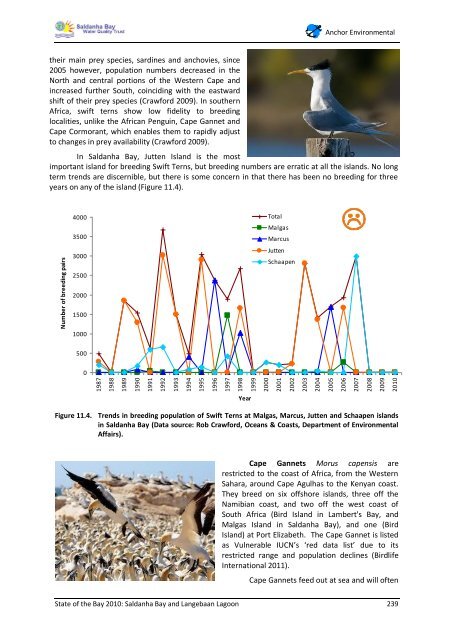State of the Bay Report 2010-Final - Anchor Environmental
State of the Bay Report 2010-Final - Anchor Environmental
State of the Bay Report 2010-Final - Anchor Environmental
Create successful ePaper yourself
Turn your PDF publications into a flip-book with our unique Google optimized e-Paper software.
<strong>the</strong>ir main prey species, sardines and anchovies, since<br />
2005 however, population numbers decreased in <strong>the</strong><br />
North and central portions <strong>of</strong> <strong>the</strong> Western Cape and<br />
increased fur<strong>the</strong>r South, coinciding with <strong>the</strong> eastward<br />
shift <strong>of</strong> <strong>the</strong>ir prey species (Crawford 2009). In sou<strong>the</strong>rn<br />
Africa, swift terns show low fidelity to breeding<br />
localities, unlike <strong>the</strong> African Penguin, Cape Gannet and<br />
Cape Cormorant, which enables <strong>the</strong>m to rapidly adjust<br />
to changes in prey availability (Crawford 2009).<br />
<strong>Anchor</strong> <strong>Environmental</strong><br />
In Saldanha <strong>Bay</strong>, Jutten Island is <strong>the</strong> most<br />
important island for breeding Swift Terns, but breeding numbers are erratic at all <strong>the</strong> islands. No long<br />
term trends are discernible, but <strong>the</strong>re is some concern in that <strong>the</strong>re has been no breeding for three<br />
years on any <strong>of</strong> <strong>the</strong> island (Figure 11.4).<br />
Number <strong>of</strong> breeding pairs<br />
4000<br />
3500<br />
3000<br />
2500<br />
2000<br />
1500<br />
1000<br />
500<br />
0<br />
1987<br />
1988<br />
1989<br />
1990<br />
1991<br />
1992<br />
1993<br />
1994<br />
1995<br />
1996<br />
1997<br />
<strong>State</strong> <strong>of</strong> <strong>the</strong> <strong>Bay</strong> <strong>2010</strong>: Saldanha <strong>Bay</strong> and Langebaan Lagoon 239<br />
1998<br />
Year<br />
1999<br />
2000<br />
Total<br />
Malgas<br />
Marcus<br />
Jutten<br />
Schaapen<br />
Figure 11.4. Trends in breeding population <strong>of</strong> Swift Terns at Malgas, Marcus, Jutten and Schaapen islands<br />
in Saldanha <strong>Bay</strong> (Data source: Rob Crawford, Oceans & Coasts, Department <strong>of</strong> <strong>Environmental</strong><br />
Affairs).<br />
2001<br />
2002<br />
2003<br />
Cape Gannets Morus capensis are<br />
restricted to <strong>the</strong> coast <strong>of</strong> Africa, from <strong>the</strong> Western<br />
Sahara, around Cape Agulhas to <strong>the</strong> Kenyan coast.<br />
They breed on six <strong>of</strong>fshore islands, three <strong>of</strong>f <strong>the</strong><br />
Namibian coast, and two <strong>of</strong>f <strong>the</strong> west coast <strong>of</strong><br />
South Africa (Bird Island in Lambert's <strong>Bay</strong>, and<br />
Malgas Island in Saldanha <strong>Bay</strong>), and one (Bird<br />
Island) at Port Elizabeth. The Cape Gannet is listed<br />
as Vulnerable IUCN’s ‘red data list’ due to its<br />
restricted range and population declines (Birdlife<br />
International 2011).<br />
2004<br />
Cape Gannets feed out at sea and will <strong>of</strong>ten<br />
2005<br />
2006<br />
2007<br />
2008<br />
2009<br />
<strong>2010</strong>

















